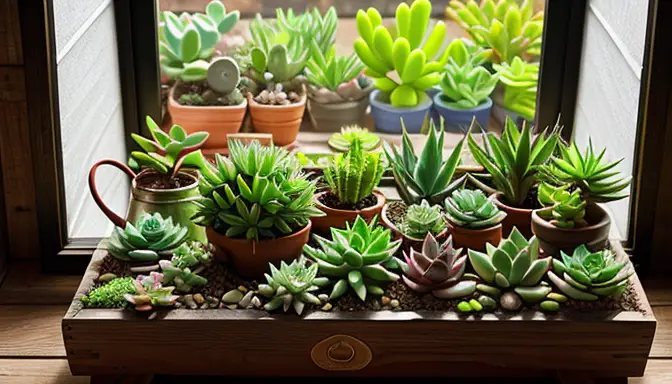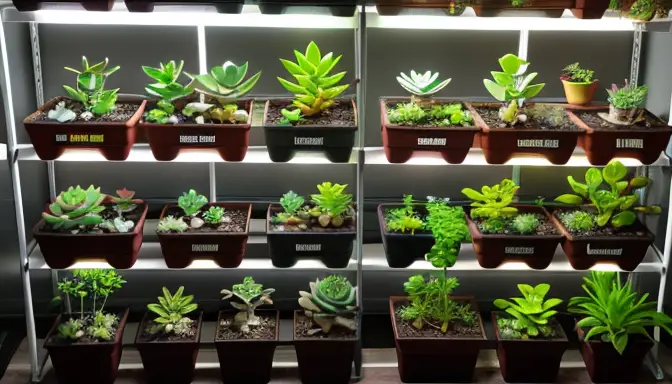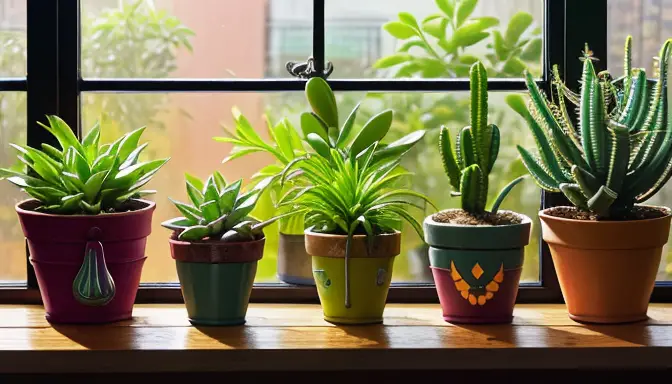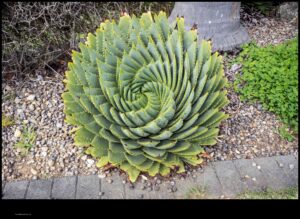When caring for succulents indoors without drainage, it’s essential to choose the right plants that can thrive in such conditions. Opt for varieties that can tolerate occasional overwatering and do well in containers without drainage holes. This initial step sets the foundation for successful succulent care in environments where water flow is limited.
Proper watering techniques play a crucial role in maintaining the health of succulents without drainage. Water sparingly and accurately, ensuring that the soil dries out between waterings to prevent issues like root rot. By following guidelines for watering, you can help your succulents thrive despite the lack of drainage.
Testing soil moisture regularly is key to determining the watering needs of succulents in containers without drainage. Methods such as the finger test or using a moisture meter can help you gauge when and how much to water your plants, preventing waterlogging and promoting healthy growth.
Using a well-draining soil mix specifically designed for succulents is crucial for ensuring proper water flow and preventing water accumulation. This specialized soil blend promotes good drainage, allowing excess water to escape and reducing the risk of root rot in plants without adequate drainage.

Monitoring light and temperature conditions is vital for indoor succulents. Understanding the light requirements of your plants and providing adequate sunlight, either through natural light from windows or artificial grow lights, is essential for their growth and overall well-being. By optimizing light exposure, you can help your succulents thrive in a drainage-challenged environment.
Preventing and treating root rot is a common concern when caring for succulents without drainage.
By identifying early signs of root rot, such as yellowing or mushy stems, and taking prompt action through adjusting watering practices or repotting, you can effectively combat this issue and ensure the long-term health of your plants..

Choosing the Right Succulents
When it comes to choosing the right succulents for indoor environments without drainage, it’s essential to select varieties that can adapt to the conditions and thrive even with occasional overwatering. Some succulents are more forgiving and resilient when it comes to moisture levels, making them ideal for containers without drainage holes. Here are some top choices:
- Aloe Vera: Known for its healing properties, aloe vera is a hardy succulent that can withstand varying watering conditions.
- Haworthia: With its attractive rosette shape, haworthia is a low-maintenance succulent that thrives in containers.
- Sansevieria: Also known as snake plant, sansevieria is a durable succulent that can survive in low light and infrequent watering.
These succulents are excellent choices for indoor spaces without drainage, providing beauty and resilience without the need for constant monitoring. Their adaptability makes them perfect companions for those looking to add greenery to their homes with minimal maintenance.

Proper Watering Techniques
Proper watering techniques are crucial for the health and well-being of your indoor succulents, especially when dealing with containers without drainage. To ensure your succulents thrive in such conditions, it’s essential to follow some guidelines:
- Water Sparingly: Succulents are adapted to survive in arid conditions, so they prefer being underwatered rather than overwatered. Allow the soil to dry out completely between waterings to prevent root rot.
- Water Accurately: When watering, ensure that you water the soil directly around the roots and avoid getting the leaves wet, as this can lead to rot or fungal issues.
- Use the “Soak and Dry” Method: Instead of frequent light waterings, give your succulents a thorough soak when watering, allowing excess water to drain out completely.
By following these proper watering techniques, you can help your succulents thrive even in containers without drainage, promoting healthy growth and preventing common issues like root rot.

Testing Soil Moisture
When it comes to testing soil moisture for your succulents growing in containers without drainage, there are several effective methods you can use to ensure you are watering them appropriately:
- Finger Test: Stick your finger about an inch into the soil and check if it feels dry or moist. Water only when the top layer is completely dry.
- Weight Test: Lift the container to feel its weight when the soil is dry and compare it to when it’s wet. This will give you an idea of when to water.
- Moisture Meters: Use a soil moisture meter to get accurate readings of the moisture content in the soil and adjust your watering schedule accordingly.
By regularly testing the soil moisture using these methods, you can prevent overwatering and ensure the health and vitality of your indoor succulents.

Using Well-Draining Soil Mix
When it comes to caring for succulents indoors without drainage, using a well-draining soil mix is crucial for their health and survival.
Succulents are prone to root rot when sitting in waterlogged soil, making the choice of soil mix a critical factor in their care..
Here are some tips on using a well-draining soil mix for your indoor succulents:
- Choose a specialized succulent or cactus potting mix that is designed to provide excellent drainage and aeration for the roots.
- Consider adding perlite or coarse sand to the soil mix to further enhance drainage capabilities and prevent water from pooling at the bottom of the container.
- Avoid using regular garden soil or potting mix, as they tend to retain too much moisture, which can be harmful to succulents.
By using a well-draining soil mix, you can create a healthy environment for your indoor succulents, allowing them to thrive without the risk of root rot caused by waterlogged soil.

Monitoring Light and Temperature
When it comes to caring for succulents indoors, monitoring light and temperature is crucial for their well-being. Succulents thrive in bright, indirect light, so it’s essential to place them near windows or under grow lights to ensure they receive an adequate amount of sunlight. By optimizing natural light exposure, you can promote healthy growth and vibrant colors in your succulents.
In addition to light, temperature plays a significant role in the health of succulents. These plants prefer warm temperatures during the day and cooler temperatures at night. Avoid exposing succulents to extreme temperature fluctuations, as this can stress the plants and affect their growth. By maintaining a consistent temperature range, you can create an ideal environment for your indoor succulents to flourish.

Optimizing Natural Light
When it comes to optimizing natural light for your indoor succulents, there are a few key factors to keep in mind to ensure their healthy growth and development. Let’s explore some essential tips to help you provide the right amount of sunlight for your plants:
- Placement: Position your succulents near windows where they can receive ample sunlight throughout the day. South and east-facing windows usually provide the best light exposure.
- Rotate: To prevent your succulents from leaning towards the light source, rotate them regularly so that all sides receive equal sunlight.
- Supplemental Lighting: If natural light is limited in your space, consider using grow lights to supplement the sunlight your succulents receive.
- Avoid Direct Sun: While succulents love sunlight, direct exposure to intense sunlight for prolonged periods can cause sunburn. Ensure they are not exposed to harsh midday sun.
By following these tips, you can optimize natural light for your indoor succulents and create an environment where they can thrive and flourish.

Preventing and Treating Root Rot
Root rot is a common issue that succulent owners may face, but with proper care and attention, it can be prevented and treated effectively. One key strategy is to ensure that the succulents are not overwatered, as excess moisture in the soil can lead to root rot. Additionally, using a well-draining soil mix can help prevent waterlogging and promote healthy root growth.
Regularly inspecting the roots of succulents for any signs of rot, such as mushy or discolored roots, is crucial in catching the problem early. If root rot is detected, immediate action should be taken to trim off the affected roots and repot the plant in fresh soil.
Furthermore, providing adequate airflow around the roots by using containers with proper drainage or adding a layer of gravel at the bottom of the pot can also help prevent root rot.
By following these preventive measures and promptly addressing any signs of root rot, succulent enthusiasts can ensure the long-term health and vitality of their plants..
Frequently Asked Questions
- Can I use any type of soil for succulents in containers without drainage holes?
It is crucial to use a well-draining soil mix specifically designed for succulents. Regular potting soil retains too much moisture and can lead to root rot.
- How often should I water succulents in containers without drainage?
Water sparingly and only when the soil is completely dry. Overwatering is a common issue in succulents without drainage, so it’s important to let the soil dry out between waterings.
- What are the signs of root rot in succulents?
Yellowing or mushy leaves, a foul odor, and soft, black roots are common signs of root rot in succulents. If detected, it’s crucial to address the issue promptly to save the plant.
- Wild Rose Country: Exploring Untamed Beauty - July 15, 2024
- Wildflower Nursery Decor: Bringing Nature Indoors - July 15, 2024
- Young Sprout of Grass: Nurturing New Life - July 15, 2024









